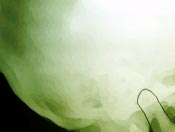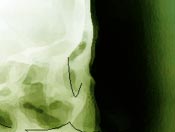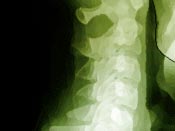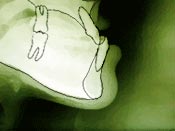 |
|
TMD
Temporomandibular Joint Disorders
in Bangkok, Thailand
Temporomandibular joint disorder (TMD) is an acute or chronic inflammation of the temporomandibular joint (TMJ).
TMJ is an abbreviation for Temporomandibular Joint, or the jaw joint. In fact, there are really two TMJs,
one in front of each ear. The TMJ is the joint formed by the temporal bone of the skull (Temporo) with the lower jaw or mandible (hence, mandibular).
The temporomandibular (TMJ) joint is used to open and close a personís mouth, allows movement up and down, side to side, and forward to back,
and is therefore necessary for biting, chewing and swallowing, speaking, and making facial expressions.
The TMJ is actually a sliding joint and not a ball-and-socket like the shoulder.




TMJ disorders are a common problem faced. These TMJ problems can result from injury, aging,
and poor dental behavior like frequent gum chewing, teeth grinding, and teeth clenching.
Although the presence of one of these symptoms does not necessarily indicate the presence of a TMJ disorder,
common symptoms of TMJ disorders include:
-
Change in occlusion (bite)
-
Dizziness
-
Headache pain
-
Hearing problems (Ringing or noises in the ears)
-
Ear pain and at times, pressure
-
Limited jaw movement
-
Pain in the face, jaw, neck, or shoulders
-
TMJ catching or locking
-
TMJ clicking or popping


To check for TMJ disorder,
Occlusion Dentist
will feel your jaw muscles and ask you if there is any pain
or tenderness. Additionally, your doctor will examine your
jaw movement and listen for any clicking or popping sounds.
Three main groups of TMJ disorders:
-
Muscle disorders describes TMJ problems located in the muscles that control the TMJ and the muscles located in a personís face and neck. These disorders are often called mysofacial disorders and are the most common of the TMJ disorders. Individuals with TMJ muscle disorders will experience pain in the muscle areas listed above.
-
Joint derangement disorders are a group of TMJ problems that is caused by either: a dislocated jaw, a displaced disk,
or an injured bone.
-
Degenerative joint disorders are a group of TMJ problems that is caused by diseases like arthritis that
destroy the cartilage that cover the TMJ and absorbs the shocks caused by such actions as chewing.
Degenerative joint disorders stem from the wear and tear of the TMJ joints.
There are several ways the TMJ disorders may be treated.
Occlusion Dentist will recommend what type of treatment is needed for your particular problem or may recommend physiotherapy
that emphasizes muscle stretching and relaxing exercises. In turn, you will be to change your daily behavior to combat your TMJ disorder.
You will have to avoid: chewing gum, eating soft foods, and opening your mouth wide to ensure that you do not worsen your TMJ condition.
In some cases, you may be required to wear a dental splint that is designed to help you reduce grinding and clenching.
This plastic device fits over the top or bottom teeth and will not create any serious disturbance to your daily routine. In extreme cases of TMJ disorder,
TMJ treatment may involve some form of surgery that can range from tightening the TMJ joint ligament to restructuring the TMJ to replacing the TMJ.

HOME
l SERVICE
l DENTISTS
l TECHNOLOGY
l FACILITIES
l ABOUT US
l SITE MAP
PROMOTION
l PRICE&DURATION
l CONSULTATION
l FAQ
l LINKS
l MAP
l TESTIMONIALS
l OUR LAB
l RESOURCES
DENTAL BRACES
l TEETH WHITENING
l IMPLANT DENTISTRY
l ENDODONTICS
l OPERATIVE DENTISTRY
l SEDATION DENTISTRY
COSMETIC DENTISTRY
l PROSTHODONTICS
l PERIODONTICS
l ORAL SURGERY
l PAEDODONTICS
l GP & ORAL EXAM
l OCCLUSION
AIR-FLOW
l DENTAL LASER SYSTEM
l ENDODONTIC EQUIPMENT
l DENTAL UNITS
l OPERATING LAMP
l WHITENING SYSTEM
CT SCAN
l DENTAL MICROSCOPES
l NOBEL GUIDE
l STERILIZATION ROOM
l X-RAY
l ELECTROSURGICAL SYSTEM
l MINIPIEZON
DENTAL OFFICE
l DENTAL CLINIC
l COSMETIC DENTISTRY
l COSMETIC DENTIST
l TEETH BLEACHING
l TOOTH WHITENING
DENTAL CROWNS
l DENTAL IMPLANTS
l DENTAL TREATMENT
l DENTAL IMPLANT
.............................................................................................................................
Copyright© 2004 SILOM DENTAL BUILDING. All Rights Reserved.
Local Call : 0 2636 9092-5, International Call : (+) 66 2636 9091, (+) 66 2636 9097
e-mail :silomdental@silomdental.com
TMD, TMJ, Temporomandibular Joint Disorders, Temporomandibular Joint, TMJ problem, Dental Occlusion, Malocclusion, Occlusion dentist, Teeth Bite
TMD
Temporomandibular Joint Disorders in Bangkok, Thailand
Temporomandibular joint disorder (TMD) is an acute or chronic inflammation of the temporomandibular joint (TMJ).
TMJ is an abbreviation for Temporomandibular Joint, or the jaw joint. In fact, there are really two TMJs, one in front of each ear. The TMJ is the joint formed by the temporal bone of the skull (Temporo) with the lower jaw or mandible (hence, mandibular). The temporomandibular (TMJ) joint is used to open and close a personís mouth, allows movement up and down, side to side, and forward to back, and is therefore necessary for biting, chewing and swallowing, speaking, and making facial expressions. The TMJ is actually a sliding joint and not a ball-and-socket like the shoulder.




TMJ disorders are a common problem faced. These TMJ problems can result from injury, aging, and poor dental behavior like frequent gum chewing, teeth grinding, and teeth clenching. Although the presence of one of these symptoms does not necessarily indicate the presence of a TMJ disorder, common symptoms of TMJ disorders include:
-
Change in occlusion (bite)
-
Dizziness
-
Headache pain
-
Hearing problems (Ringing or noises in the ears)
-
Ear pain and at times, pressure
-
Limited jaw movement
-
Pain in the face, jaw, neck, or shoulders
-
TMJ catching or locking
-
TMJ clicking or popping
 |
 |
To check for TMJ disorder, Occlusion Dentist will feel your jaw muscles and ask you if there is any pain or tenderness. Additionally, your doctor will examine your jaw movement and listen for any clicking or popping sounds.
Three main groups of TMJ disorders:
-
Muscle disorders describes TMJ problems located in the muscles that control the TMJ and the muscles located in a personís face and neck. These disorders are often called mysofacial disorders and are the most common of the TMJ disorders. Individuals with TMJ muscle disorders will experience pain in the muscle areas listed above.
-
Joint derangement disorders are a group of TMJ problems that is caused by either: a dislocated jaw, a displaced disk, or an injured bone.
-
Degenerative joint disorders are a group of TMJ problems that is caused by diseases like arthritis that destroy the cartilage that cover the TMJ and absorbs the shocks caused by such actions as chewing. Degenerative joint disorders stem from the wear and tear of the TMJ joints.
There are several ways the TMJ disorders may be treated. Occlusion Dentist will recommend what type of treatment is needed for your particular problem or may recommend physiotherapy that emphasizes muscle stretching and relaxing exercises. In turn, you will be to change your daily behavior to combat your TMJ disorder. You will have to avoid: chewing gum, eating soft foods, and opening your mouth wide to ensure that you do not worsen your TMJ condition. In some cases, you may be required to wear a dental splint that is designed to help you reduce grinding and clenching. This plastic device fits over the top or bottom teeth and will not create any serious disturbance to your daily routine. In extreme cases of TMJ disorder, TMJ treatment may involve some form of surgery that can range from tightening the TMJ joint ligament to restructuring the TMJ to replacing the TMJ.
HOME
l SERVICE
l DENTISTS
l TECHNOLOGY
l FACILITIES
l ABOUT US
l SITE MAP
PROMOTION
l PRICE&DURATION
l CONSULTATION
l FAQ
l LINKS
l MAP
l TESTIMONIALS
l OUR LAB
l RESOURCES
DENTAL BRACES
l TEETH WHITENING
l IMPLANT DENTISTRY
l ENDODONTICS
l OPERATIVE DENTISTRY
l SEDATION DENTISTRY
COSMETIC DENTISTRY
l PROSTHODONTICS
l PERIODONTICS
l ORAL SURGERY
l PAEDODONTICS
l GP & ORAL EXAM
l OCCLUSION
AIR-FLOW
l DENTAL LASER SYSTEM
l ENDODONTIC EQUIPMENT
l DENTAL UNITS
l OPERATING LAMP
l WHITENING SYSTEM
CT SCAN
l DENTAL MICROSCOPES
l NOBEL GUIDE
l STERILIZATION ROOM
l X-RAY
l ELECTROSURGICAL SYSTEM
l MINIPIEZON
DENTAL OFFICE
l DENTAL CLINIC
l COSMETIC DENTISTRY
l COSMETIC DENTIST
l TEETH BLEACHING
l TOOTH WHITENING
DENTAL CROWNS
l DENTAL IMPLANTS
l DENTAL TREATMENT
l DENTAL IMPLANT
............................................................................................................................. Copyright© 2004 SILOM DENTAL BUILDING. All Rights Reserved.
Local Call : 0 2636 9092-5, International Call : (+) 66 2636 9091, (+) 66 2636 9097
e-mail :silomdental@silomdental.com
TMD, TMJ, Temporomandibular Joint Disorders, Temporomandibular Joint, TMJ problem, Dental Occlusion, Malocclusion, Occlusion dentist, Teeth Bite